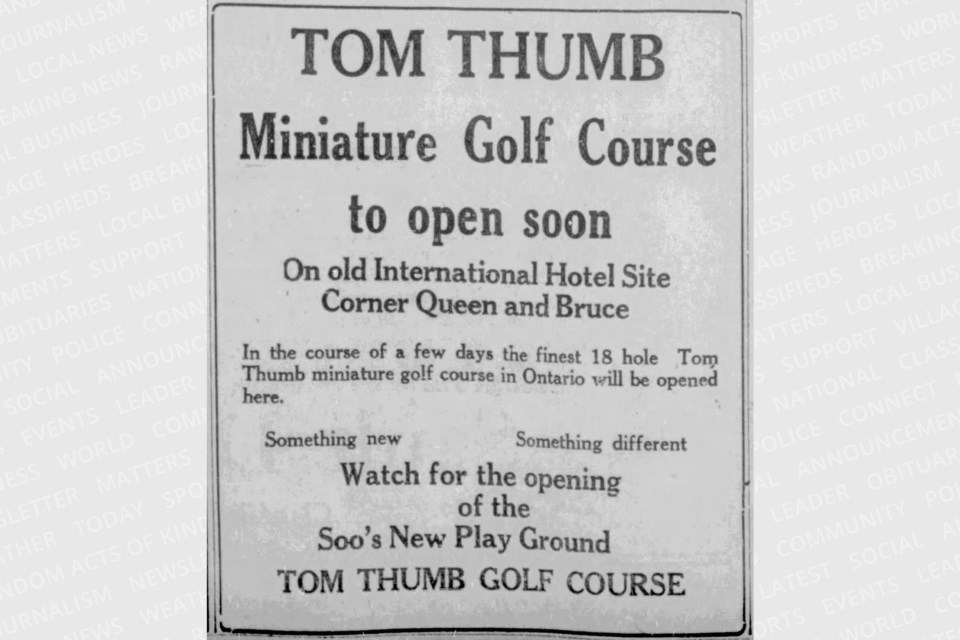From the archives of the Sault Ste. Marie Public Library:
Many of us have fond memories of playing on a miniature golf course, avoiding imaginative obstacles and tricky traps in a quest to score a hole-in-one.
The earliest known course, called a Gofstacle, was first referenced in 1912, although it was largely just a scaled-down version of a typical golf game.
In 1926, Garnet Carter invented what became known as Tom Thumb Golf in Georgia, USA; unlike previous games of mini-golf, this included more whimsical, fantastical elements. With its obstacles, decorations, and statues, it resembled the game as we know it today, and popularity spread like wildfire. Carter patented the game and franchised it. It became a craze throughout the late 1920s and early 1930s; in 1930, there were an estimated 25,000 Tom Thumb Golf courses in the USA alone.
Journalist Robert Reade tried to describe the popularity in an article reprinted by the Sault Daily Star: “Historians perhaps will remember the year 1930 as the year which saw the commencement of the Tom Thumb mania. It is a pandemic which has had more victims than the bubonic plague, yellow fever, influenza or the strange dancing madness that swept over the Middle Ages. It is still raging. No one knows when it will stop or if it ever will stop. It is spreading all over the world and as yet there is in sight no cure for it.”
Sault Ste. Marie was not immune to the craze. Locally, plans soon emerged to build a Tom Thumb Golf Course on the International Hotel Grounds at Queen and Bruce, the location of a devastating fire that saw the building burn down in 1916. The course would boast 18 holes, artificial grass, and parking for hundreds of cars. Managed by a Mr. M Frankel, it promised to be “the best [course] this side of Florida.”
While the course was set to open on Saturday, July 26, 1930, the grand opening was pushed one day early, thanks to the early completion of construction. The first game was held between Mayor Jack McLarty and prominent Rotarian Bill Marshall.
Bill Marshall was certainly confident in his miniature golfing abilities; he scoped out the course in advance and told the Sault Daily Star, “I don’t need any practice to trim the mayor at that game.” However, his confidence may have been a bit misplaced. The mayor trounced him 88 to 114.
The Tom Thumb Golf Course managers certainly knew how to draw crowds, offering fundraisers for Rotary Day and prizes; in one competition, they offered $5 in gold to the player with the lowest score that week. In August 1930, they advertised free miniature golfing to children under the age of fifteen for one morning… and were overrun with participants.
As the Sault Daily Star reported, “About 300 children stormed the entrance to the course this morning and swarmed over the peewee greens, to the despair of those who try to keep the greens smooth and level. Most of the youngsters weren’t satisfied with just one round either, and this added to the confusion. Two policemen were needed to keep order in the lineup at the entrance, and at that, they managed to break down part of the fence.”
As popular as it was with children, the Tom Thumb course was also enjoyed by adults. The Sault Daily Star noted that it was “getting a great play from the women folk,” who found success swinging the ball with “a broom swinging stance.” The columnist noted, "if it helps to keep our grandmothers off the corners and out of the pool rooms, more power to it.”
However, there were some who were unhappy with the popularity of the golf course – particularly on Sundays. Some felt that like many other buildings, it should be closed on Sundays. Others argued that there should be no different treatment between Tom Thumb courses and regular golf courses, which were allowed to be opened.
The Lord’s Day Alliance appealed to city council to have the golf course closed on Sundays, a request which was ultimately denied as it would have meant changing the license council had originally granted the course.
The miniature golf craze was so great that a second course soon opened up in August 1930, called the Golfette. This one, located at the Old Stone House, caused some confusion when it was being built, with at least one visitor to Sault Ste. Marie inquiring if all the digging going on was in pursuit of buried historic treasure. It wasn’t… but the digging accidentally uncovered the remains of a stone wall that had at one time been a jail cell.
The Golfette offered afternoon tea, live music, a dance floor, and more. In its advertising, it proclaimed itself as being “improved miniature golf.” Like Tom Thumb, it had eighteen holes, but these ones were “novel” and “[provided] the golfer with food for thought and the opportunity to show real putting ability.” Regular tournaments boasted prizes such as “a real Algoma turkey,” silk stockings, chocolate, potatoes, bacon, coal, sugar, ham, and the like.
Ultimately, the miniature golf craze of the 1930s would die out – but not completely. Courses would continue to pop up and be enjoyed by players of all ages, although likely not with the same intense popularity that Tom Thumb and the Golfette enjoyed.
Each week, the Sault Ste. Marie Public Library and its Archives provide SooToday readers with a glimpse of the city’s past.
Find out more of what the Public Library has to offer at www.ssmpl.ca and look for more "Remember This?" columns here.
